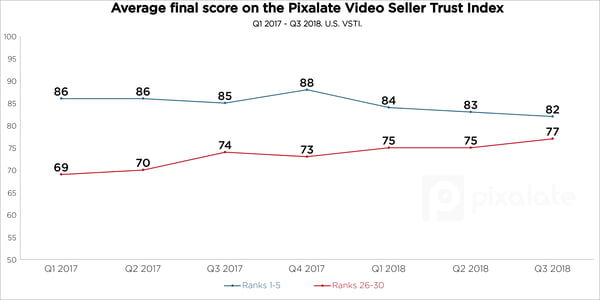
This week's review of ad fraud and quality in the digital advertising space.
Attending Mobile World Congress 2019? Meet with Pixalate to discuss the latest trends in mobile advertising.

This eMarketer podcast features Nicole Perrin, author of eMarketer's recently released Digital Ad Fraud 2019 report, as she explains some of the key takeaways from the comprehensive report. "I think the top two areas [of risky inventory] have got to be mobile app and OTT," said Perrin.

Pixalate recently released the Q3 2018 Seller Trust Indexes, and we examined historical data from the Video Seller Trust Index (VSTI) to identify some industry-wide trends.
Per the VSTI, competition among programmatic video ad sellers has increased, and as a result, there is now less risk in “choosing the wrong partner” for programmatic video. Learn more.

"The good news is that the Interactive Advertising Bureau's ads.txt initiative has seen a remarkably fast compliance among the world's top website publishers doing business with big advertisers and ad agencies. The bad news is that nothing's perfect," wrote MediaPost, in reference to a report that ad fraudsters targeted ads.txt.
"We work hard to protect our clients from such schemes through our pre-bid technology and tools we provide for supply rating and data intelligence," Amin Bandeali, CTO of Pixalate, said to MediaPost. "At the end of the day, fraudsters will always seek to game the system because they are so highly incentivized. Scammers are constantly inventing, and it’s up to each stakeholder to carefully vet and monitor their sources and partners."

According to a new report from the Interactive Advertising Bureau (IAB), "digital ad revenue was $26.2 billion in the third quarter of 2018 -- up a whopping 22% compared to the same quarter a year prior," wrote MediaPost.
“Last year saw significant growth in the OTT marketplace and in the direct-to-consumer brand ecosystem — contributing factors in digital’s successful Q3,” Sue Hogan, SVP or Research and Measurement at the IAB, said in a statement.

"A massive majority of consumers believe that using their data to personalize ads is unethical," wrote Forbes, citing an RSA survey of over 6,000 European and American adults. The author asked why people continue to use services that use their data for personalization if they are so strongly against it, before noting: "From a European perspective, the answer might be that they actually lack choice."
*By entering your email address and clicking Subscribe, you are agreeing to our Terms of Use and Privacy Policy.
These Stories on Weekly Recaps
*By entering your email address and clicking Subscribe, you are agreeing to our Terms of Use and Privacy Policy.

Disclaimer: The content of this page reflects Pixalate’s opinions with respect to the factors that Pixalate believes can be useful to the digital media industry. Any proprietary data shared is grounded in Pixalate’s proprietary technology and analytics, which Pixalate is continuously evaluating and updating. Any references to outside sources should not be construed as endorsements. Pixalate’s opinions are just that - opinion, not facts or guarantees.
Per the MRC, “'Fraud' is not intended to represent fraud as defined in various laws, statutes and ordinances or as conventionally used in U.S. Court or other legal proceedings, but rather a custom definition strictly for advertising measurement purposes. Also per the MRC, “‘Invalid Traffic’ is defined generally as traffic that does not meet certain ad serving quality or completeness criteria, or otherwise does not represent legitimate ad traffic that should be included in measurement counts. Among the reasons why ad traffic may be deemed invalid is it is a result of non-human traffic (spiders, bots, etc.), or activity designed to produce fraudulent traffic.”

